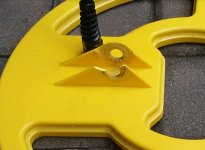I have to disagree. PLA is stronger (ultimate strength) than PETG. It also deforms less before it breaks, which is very important here, trying to prevent the coil's ears from breaking. PETG is more impact resistant, though, more "rubbery" if you will, and can handle higher temperatures, which makes it better for some applications.
Both absorb water, PETG is worse, but how that affects useful life, if at all, I couldn't say. I'd be interested to hear more anecdotal reports of which plastic holds up better in freshwater or seawater...
Print infill percent (how hollow the interior of the part is) directly affects strength, and print orientation are also very important. The direction of lamination (Z axis) is considerably weaker than the X or Y directions, in shear or tension. So yeah, Toysoldier nailed it, if printed with the base flat on the bed, with the "ears" upright, would make for weaker ears more likely to snap off.
And yeah, beachrumbum is right, print temperature and bed temperature can both contribute to stronger prints, as well as layer height and/or linewidth/layer height ratio, and a host of other factors, too.
And of course, the design of the stiffener is a big deal, too. I make mine so they grip the base of the coil for extra stability, and with beefy fillets holding the stiffener's ears to its base. Printed solid, and printed "nose-up" for the best ear strength.
Lostandfound, what kind of stiffener did you have that broke?
Link to pix of my prototype and V2. Current (V3) version has even more ear support.
https://metaldetectingforum.com/showthread.php?t=285729


 ok guilty as charged.
ok guilty as charged.